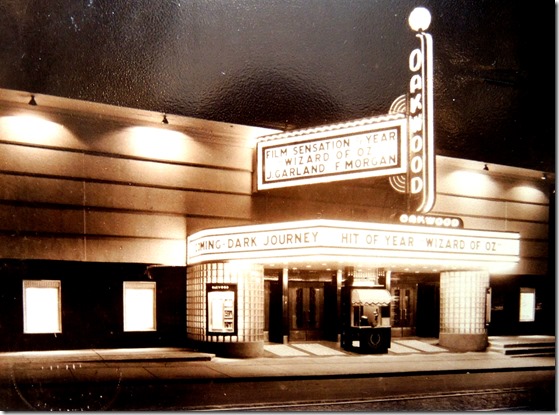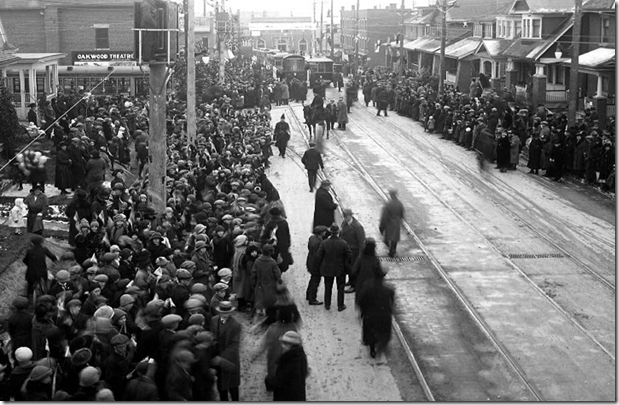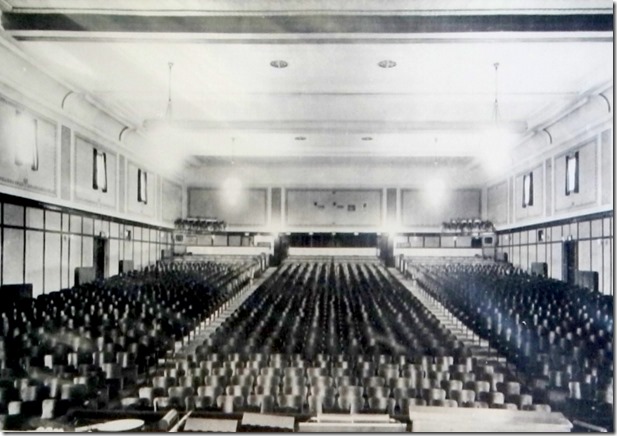The Oakwood Theatre in 1939, the film “Wizard of Oz” on the marquee as the featured film. The “coming attraction” is advertised as being “Dark Journey,” released in January 1937. The latter film was a romantic drama starring Vivien Leigh and Conrad Veidt, set amidst the turmoil of the First World War. Photo, City of Toronto Archives, Series 881, File 350.
The Oakwood is one of Toronto’s movie theatres from former years that stands out vividly in my mind. In the 1940s, as a child, I caught a glimpse of it many times from the windows of the Oakwood streetcars. Our family travelled on these streetcars whenever we journeyed downtown. On Sundays, when the law demanded that theatres close, if it were a hot day, we passed the theatre when we went to Centre Island. For these excursions, we journeyed on an Oakwood streetcar as far and St. Clair, where we boarded a Bay streetcar to go to the ferry docks. In the 1940s, the Oakwood streetcars were in Zone Two and the Bay streetcars in Zone One. Although both were operated by the TTC, free transfers between the two zones was not permitted, each requiring a separate fare.
In later years, when I was a teenager, I boarded the streetcars to go to the Oakwood Theatre to view films. I do not recall any of the films that I saw, but I remember that I was impressed by the size and grandeur of its auditorium. It was huge compared with the two theatres within walking distance of our house—the Grant and the Colony. As well, the Oakwood’s candy bar was larger. The theatre always screened two film, and between films, patrons who wished to enjoy a cigarette came out on the street at intermission. A friend and I sometimes mingled with the smokers and strolled in without purchasing a ticket. We considered this a “real lark,” as we used to say.
The Oakwood Theatre was located at 165 Oakwood Avenue, in city’s historic District of Earlscourt, which centred on St. Clair Avenue West and Dufferin Street. In the first decade of the twentieth century, the area was not part of the City of Toronto as it was remote from the downtown area. The enormous hill north of Davenport Road created a geographic barrier that separated it from the city below the hill. If residents of Earlscourt wished to travel to downtown Toronto, they walked down the hill and boarded a streetcar at Van Horne (now named Dupont) and Dufferin Streets. The return journey up the hill was considerable more arduous, especially in winter.
The first streetcar line that travelled up over the hill was built on Yonge Street in the 1890s. Within a few years, another streetcar line was constructed on Avenue Road. However, in the Earlscourt area, the isolation did not end until 1913, when a streetcar line was built along St. Clair Avenue West that connected with the Avenue Road streetcar. The St. Clair streetcar extended from Avenue Road, as far west as Lansdowne Avenue.
After the streetcar line opened, commercial development along St. Clair Avenue West rapidly increased. As a result, more houses appeared on the streets to the north and south of the St. Clair Avenue. However, it remained a daunting journey to travel downtown on the streetcar. Most people only journeyed downtown for work, visiting relatives or an occasional shopping excursion at the major department stores at Yonge and Queen Streets. However, because the population of the area had increased, the potential for local movie houses within walking distance of the homes was readily seen. One of the busier north-south streets in the area was Oakwood Avenue. Thus, the intersection at Oakwood and St. Clair became an ideal location for a theatre.
A real estate developer, James Crang Jr., purchased property on the east side of Oakwood, a short distance north of St. Clair. The theatre opened in 1917, its postal address 165 Oakwood Avenue. Its only competition at the time was the Royal George Theatre, which was considerably smaller, was located at St. Clair and Dufferin Streets. The façade of the Oakwood Theatre was relatively unadorned, the slanted roof above the façade possessing terracotta tiles, considered quite fashionable in the early decades of the twentieth century. Below the marquee, at either end, were large rounded glass pillars-like structures. The box office was in a central position between them, the doors to the theatre recessed behind the box office.
The theatre’s auditorium contained almost 1400 wood-back seats. The seating was arranged with a centre section, and aisles on either side of it. There were two side sections, but no balcony. The ceiling contained horizontal decorative lines, similar to the theatre’s façade. The north and south walls possessed a combination of horizontal and vertical lines, the design simple but attractive. On the ceiling were large crystal chandeliers. When I attended the theatre in the 1950s, I do not recall ever having seen them. They might have been removed due to maintenance costs, or perhaps, the reason I do not remember them is because I usually entered the theatre after the house-lights had been dimmed, as the movie was already in progress.
In the 1950s, people departed their homes to attend a movie at whatever time suited them. They were not concerned about the starting times of the films. After viewing part of a movie, they remained seated to view the part that they had missed. This meant that people were entering and departing the theatre throughout the screenings. Ushers and usherettes were required, using flashlights to assist people to find their seats. This is not as prevalent today, as patrons tend to arrive at the beginning of a film and when they enter the auditorium, the theatre’s auditorium lights are on.
One of my cousins worked at the Oakwood Theatre in the 1950s as an usherette. We all envied her as we knew that while showing people to their seats, she was able to catch a glimpse of the movies. On evenings when there were few patrons, she could stand at the back of the theatre and watch the movie. When I attended the Oakwood Theatre, it always screened two films. Due to a tight budget, it was unable to afford to rent recently released films.
Theatres across the city suffered during the late-1950s as the popularity of television increased. The Oakwood was one of the first to succumb to the onslaught of the new entertainment medium. The theatre shut its doors in 1962 and was demolished. On the site today is an apartment building with the address 161 Oakwood Avenue.
This crowded scene gazes south on Oakwood Avenue toward St. Clair, on November 19, 1924, when the Oakwood streetcar line was officially inaugurated. The Oakwood Theatre can be seen in the upper left-hand side of the photos, an Oakwood car on the north side of the theatre, coming out of the streetcar loop that circled around the theatre. City of Toronto Archives, Series 71, S0071, It. 3528.
Auditorium of the Oakwood Theatre, photo from Toronto Reference Library
To view the Home Page for this blog: https://tayloronhistory.com/
To view previous blogs about movie houses of Toronto—historic and modern
Recent publication entitled “Toronto’s Theatres and the Golden Age of the Silver Screen,” by the author of this blog. The publication explores 50 of Toronto’s old theatres and contains over 80 archival photographs of the facades, marquees and interiors of the theatres. It relates anecdotes and stories of the author and others who experienced these grand old movie houses.
To place an order for this book:
Book also available in Chapter/Indigo, the Bell Lightbox Book Store and by phoning University of Toronto, Press Distribution: 416-667-7791
Theatres Included in the Book:
Chapter One – The Early Years—Nickelodeons and the First Theatres in Toronto
Theatorium (Red Mill) Theatre—Toronto’s First Movie Experience and First Permanent Movie Theatre, Auditorium (Avenue, PIckford), Colonial Theatre (the Bay), the Photodome, Revue Theatre, Picture Palace (Royal George), Big Nickel (National, Rio), Madison Theatre (Midtown, Capri, Eden, Bloor Cinema, Bloor Street Hot Docs), Theatre Without a Name (Pastime, Prince Edward, Fox)
Chapter Two – The Great Movie Palaces – The End of the Nickelodeons
Loew’s Yonge Street (Elgin/Winter Garden), Shea’s Hippodrome, The Allen (Tivoli), Pantages (Imperial, Imperial Six, Ed Mirvish), Loew’s Uptown
Chapter Three – Smaller Theatres in the pre-1920s and 1920s
Oakwood, Broadway, Carlton on Parliament Street, Victory on Yonge Street (Embassy, Astor, Showcase, Federal, New Yorker, Panasonic), Allan’s Danforth (Century, Titania, Music Hall), Parkdale, Alhambra (Baronet, Eve), St. Clair, Standard (Strand, Victory, Golden Harvest), Palace, Bedford (Park), Hudson (Mount Pleasant), Belsize (Crest, Regent), Runnymede
Chapter Four – Theatres During the 1930s, the Great Depression
Grant ,Hollywood, Oriole (Cinema, International Cinema), Eglinton, Casino, Radio City, Paramount, Scarboro, Paradise (Eve’s Paradise), State (Bloordale), Colony, Bellevue (Lux, Elektra, Lido), Kingsway, Pylon (Royal, Golden Princess), Metro
Chapter Five – Theatres in the 1940s – The Second World War and the Post-War Years
University, Odeon Fairlawn, Vaughan, Odeon Danforth, Glendale, Odeon Hyland, Nortown, Willow, Downtown, Odeon Carlton, Donlands, Biltmore, Odeon Humber, Town Cinema
Chapter Six – The 1950s Theatres
Savoy (Coronet), Westwood
Chapter Seven – Cineplex and Multi-screen Complexes
Cineplex Eaton Centre, Cineplex Odeon Varsity, Scotiabank Cineplex, Dundas Square Cineplex, The Bell Lightbox (TIFF)



![cid_E474E4F9-11FC-42C9-AAAD-1B66D852[2] cid_E474E4F9-11FC-42C9-AAAD-1B66D852[2]](https://tayloronhistory.com/wp-content/uploads/2015/01/cid_e474e4f9-11fc-42c9-aaad-1b66d8522_thumb.jpg)
Born in 1948 I spent every Saturday afternoon at the Oakwood Theater until it closed. Two films that come to mind are House on Haunted Hill with the flying skeleton and The Tingler with the wired seats. I became a 40 year entertainment writer and found a Crang family member (remember the plaza?) running a small theater in New Liskeard. We should talk [email protected] 905242-4317.